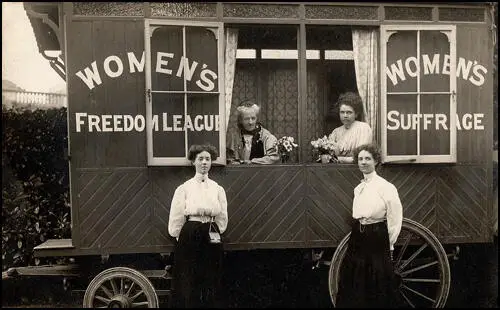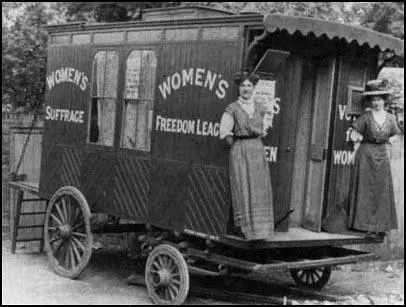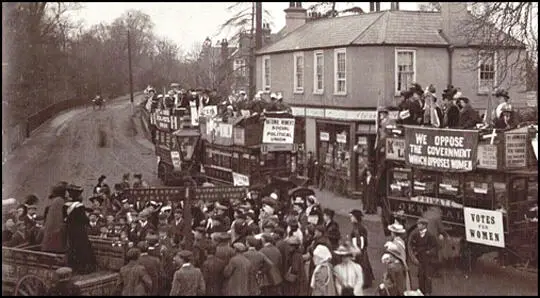Women's Freedom League Caravans
In 1907 Charlotte Despard, Teresa Billington-Greig, Edith How-Martyn, Dora Marsden, Helena Normanton, Anne Cobden Sanderson, Emma Sproson, Margaret Nevinson, Henria Williams, Violet Tillard and seventy other members of the Women's Social and Political Union left to form the Women's Freedom League (WFL). Most of its members were socialists who wanted to work closely with the Labour Party who "regarded it as hypocritical for a movement for women's democracy to deny democracy to its own members." (1)

Irene Tillard and Violet Tillard standing in front of the caravan.
Violet Tillard became Assistant Organising Secretary of the organisation. She was active in promoting women's suffrage in newspapers. In one letter she pointed out the difference between the Women's Freedom League and the Women Social & Political Union. "The Women's Freedom League differs from the Women's Social and Political Union chiefly in the internal organisation, which in democratic; and in the fact that it is not part of its policy at present to interrupt Cabinet Ministers at meetings; but the societies at one in their aim the removal of the sex disability, and in their policy of opposing the Government at bye-elections." (2)

Violet Tillard helped establish branches of the League on a caravan tour of the south-east counties of England. Tillard also established WFL branches in Ipswich, Carmarthen and Cardiff. In November, 1908, the caravan visited visited Sussex. On 28th Tillard spoke at a meeting at Upminster addressed by Alice Schofield and Henria Williams. (3)

at Upminster with Alice Schofield and Violet Tillard (28th November 1908)
The Women's Freedom League grew rapidly, and soon had sixty branches throughout Britain with an overall membership of about 4,000 people. This was over twice the size of the WSPU. The WFL also established its own newspaper, The Vote. Two of the WFL leaders, Teresa Billington-Greig and Charlotte Despard, were both talented writers and were the main people responsible for producing the newspaper. It was used to inform the public of WFL campaigns such as the refusal to pay taxes and to fill in the 1911 Census forms. One of Britain's leading writers, Cicely Hamilton, became editor of the newspaper. (4)
Primary Sources
(1) Upminster's Tragic Link to Black Friday (28th November, 2014)
Like many villages Upminster had hosted suffragettes' rallies. On Tuesday 16th April 1907 a meeting under the title of "Votes for Women" was organised at Upminster's Boys' School House with the advertised speakers being amongst the most famous suffragettes in Britain at that time. One was Mrs Charlotte Despard, imprisoned in Holloway Prison twice that year and who had the previous year left the National Union of Women's Suffrage Societies (NUWSS) and joined the Women's Social and Political Union (WSPU), formed by Mrs Emmeline Pankhurst and her three daughters, Christabel, Sylvia and Adela Pankhurst. The second speaker was to be Mrs Emmeline Pethick-Lawrence, who with her husband Frederick that year started the journal Votes for Women and contributed more than £6,000 of their own funds to the WSPU. Their large home in London also became the office of the WSPU and was also used as a place of convalescence for suffragettes made ill by their prison experiences. The third advertised speaker was a Miss Macauley. In the event it was Mrs Despard and Miss Christabel Pankhurst, described in the local press as "the pretty, rosy cheeked, young Suffragette", who addressed the meeting which attracted such a large attendance that an overflow meeting had to be held.
A second suffragettes rally took place in Upminster eighteen months later when on 28th November 1908 the village was visited by members of the Women's Freedom League (WFL), another of the different suffrage factions. The meeting had as the main speaker a Miss Tillard, either Violet Tillard the very active Organising Secretary of the WFL or her younger sister Irene, and another Suffragette was named as a Miss Schofield, almost certainly Alice Schofield, one of the founders and paid organiser of the WFL. The meeting was chaired by a Miss Williams and it was to her that Upminster owes its strong historic link to the suffrage movement as this last Miss Henria Williams was among the "Black Friday" protestors and her treatment on that day quickly became a cause celebre for Suffragettes.

